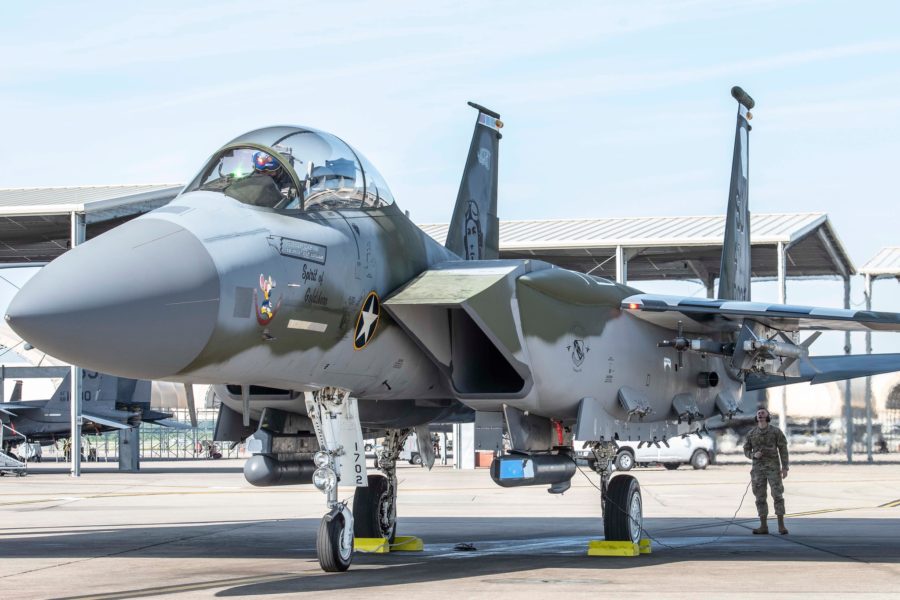Audio of this article is brought to you by the Air & Space Forces Association, honoring and supporting our Airmen, Guardians, and their families. Find out more at afa.org
Eagle-eyed World War II buffs at the Wings over Wayne airshow in North Carolina this weekend will be challenged to catch all the historical references adorning the 4th Fighter Wing’s F-15E flagship jet.
From nose to the tail, the F-15E Strike Eagle‘s heritage paint job offers tribute to the wing’s historic lineage, which traces back to the 4th Fighter Group in World War II. Now based at Seymour Johnson Air Force Base, N.C., the wing highlighted the jet’s new look in a recent Facebook post.
Perhaps most striking: A portrait on the inside face of the right tail depicting renowned Ace Col. Donald Blakeslee, believed by many to have flown more missions and hours in World War II than any other American fighter pilot and credited with 17 aerial victories. Blakeslee scored the first air-to-air kill in a P-47 Thunderbolt and flew escort on the first bombing mission over Berlin. Under his command, the 4th Fighter Group destroyed more than 1,000 German aircraft.
On the outside of the left tail, just above the tail code, the jet sports the Royal Air Force Eagle Squadrons emblem, recognizing the American volunteers who flew those planes in the early days of WWII before the U.S. entered the war. Those squadrons eventually became the 334th, 335th, and 336th Fighter Squadrons of the 4th Fighter Group.
Other historic references in the paint scheme include a flaming spear meant to represent “the performance of the 4th Fighter Group in WWII and how the 4th Fighter Wing currently serves as the ‘tip of the spear’ for the United States Air Force,” a wing spokesperson told Air & Space Forces Magazine.
Just below the cockpit is the blue and yellow National Star Insignia used by the 4th Fighter Group during the war. And near the nose, a cartoon “fighting eagle” that appeared on the planes of historic Aces William Dunn and Don Gentile
“Invasion Stripes”—alternating black and white stripes—dress up the wing tops as they did on 4th Fighter Group aircraft during World War II and the Korean War.
Finally, its green and gray camouflage pattern pays homage to the group’s Supermarine Spitfires, which flew from September 1942 to March 1943.
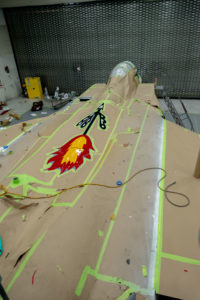
Airmen assigned to the 4th Equipment Maintenance Squadron, fabrications flight paint a spear on the top of an F-15E Strike Eagle during a heritage repaint effort at Seymour Johnson Air Force Base, North Carolina, April 11, 2023. The spear represents the performance of the 4th Fighter Group in World War II, and how the 4th Fighter Wing currently serves as the “tip of the spear” for the Air Force. U.S. Air Force photo by Airman 1st Class Rebecca Sirimarco-Lang
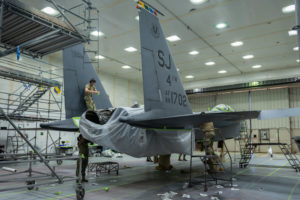
Airmen assigned to the 4th Equipment Maintenance Squadron fabrications flight prepare an F-15E Strike Eagle to be painted at Seymour Johnson Air Force Base, North Carolina, March 14, 2023. U.S. Air Force photo by Airman 1st Class Rebecca Sirimarco-Lang
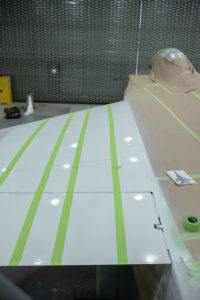
Airmen assigned to the 4th Equipment Maintenance Squadron fabrications flight paint white stripes on the wing of an F-15E Strike Eagle at Seymour Johnson Air Force Base, North Carolina, April 3, 2023. U.S. Air Force photo by Airman 1st Class Rebecca Sirimarco-Lang
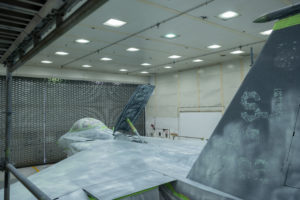
An F-15E Strike Eagle undergoes the priming process as part of a paint job at Seymour Johnson Air Force Base, North Carolina, March 23, 2023. U.S. Air Force photo by Airman 1st Class Rebecca Sirimarco-Lang
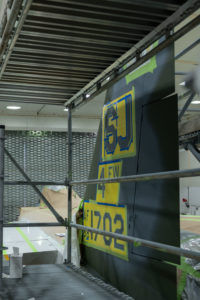
The tail of an F-15E Strike Eagle is stenciled as part of a repaint effort at Seymour Johnson Air Force Base, North Carolina, April 3, 2023. U.S. Air Force photo by Airman 1st Class Rebecca Sirimarco-Lang
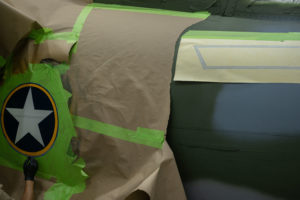
An airman assigned to the 4th Equipment Maintenance Squadron fabrications flight touches up paint on an F-15E Strike Eagle during a heritage repaint effort at Seymour Johnson Air Force Base, North Carolina, April 11, 2023. U.S. Air Force photo by Airman 1st Class Rebecca Sirimarco-Lang
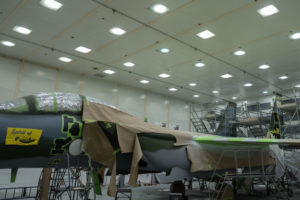
Airmen assigned to the 4th Equipment Maintenance Squadron fabrications flight use stencils to paint an F-15E Strike Eagle at Seymour Johnson Air Force Base, North Carolina, April 3, 2023. Stencils help EMS airmen precisely paint safety indicators on the aircraft such as dangerous areas and where to walk. U.S. Air Force photo by Airman 1st Class Rebecca Sirimarco-Lang
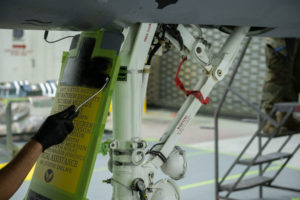
Airmen assigned to the 4th Equipment Maintenance Squadron fabrications flight paint a stencil with the names of the Airmen who painted the flagship jet at Seymour Johnson Air Force Base, North Carolina, April 12, 2023. U.S. Air Force photo by Airman 1st Class Rebecca Sirimarco-Lang
It took more than a month for the 4th Equipment Maintenance Squadron to complete the elaborate paint scheme, which made its debut April 25.
Four other flagships—for the 333rd, 334th, 335th, and 336th Fighter Squadrons—each with their own references and homages, will also be on display at Wings over Wayne. The airshow is open to the public on Seymour Johnson May 20-21.
Audio of this article is brought to you by the Air & Space Forces Association, honoring and supporting our Airmen, Guardians, and their families. Find out more at afa.org
